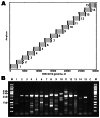Full-genome deep sequencing and phylogenetic analysis of novel human betacoronavirus
- PMID: 23693015
- PMCID: PMC3647518
- DOI: 10.3201/eid1905.130057
Full-genome deep sequencing and phylogenetic analysis of novel human betacoronavirus
Abstract
A novel betacoronavirus associated with lethal respiratory and renal complications was recently identified in patients from several countries in the Middle East. We report the deep genome sequencing of the virus directly from a patient's sputum sample. Our high-throughput sequencing yielded a substantial depth of genome sequence assembly and showed the minority viral variants in the specimen. Detailed phylogenetic analysis of the virus genome (England/Qatar/2012) revealed its close relationship to European bat coronaviruses circulating among the bat species of the Vespertilionidae family. Molecular clock analysis showed that the 2 human infections of this betacoronavirus in June 2012 (EMC/2012) and September 2012 (England/Qatar/2012) share a common virus ancestor most likely considerably before early 2012, suggesting the human diversity is the result of multiple zoonotic events.
Keywords: computer-aided design; coronavirus infections; disease transmission; evolution; high-throughput nucleotide sequencing; infectious; molecular; respiratory tract infections; viruses; zoonoses.
Figures




References
-
- Bermingham A, Chand M, Brown C, Aarons E, Tong C, Langrish C, et al. Severe respiratory illness caused by a novel coronavirus in a patient transferred to the United Kingdom from the Middle East, September 2012. Euro Surveill. 2012;17:20290 . - PubMed
Publication types
MeSH terms
Substances
Associated data
- Actions
Grants and funding
LinkOut - more resources
Full Text Sources
Other Literature Sources
